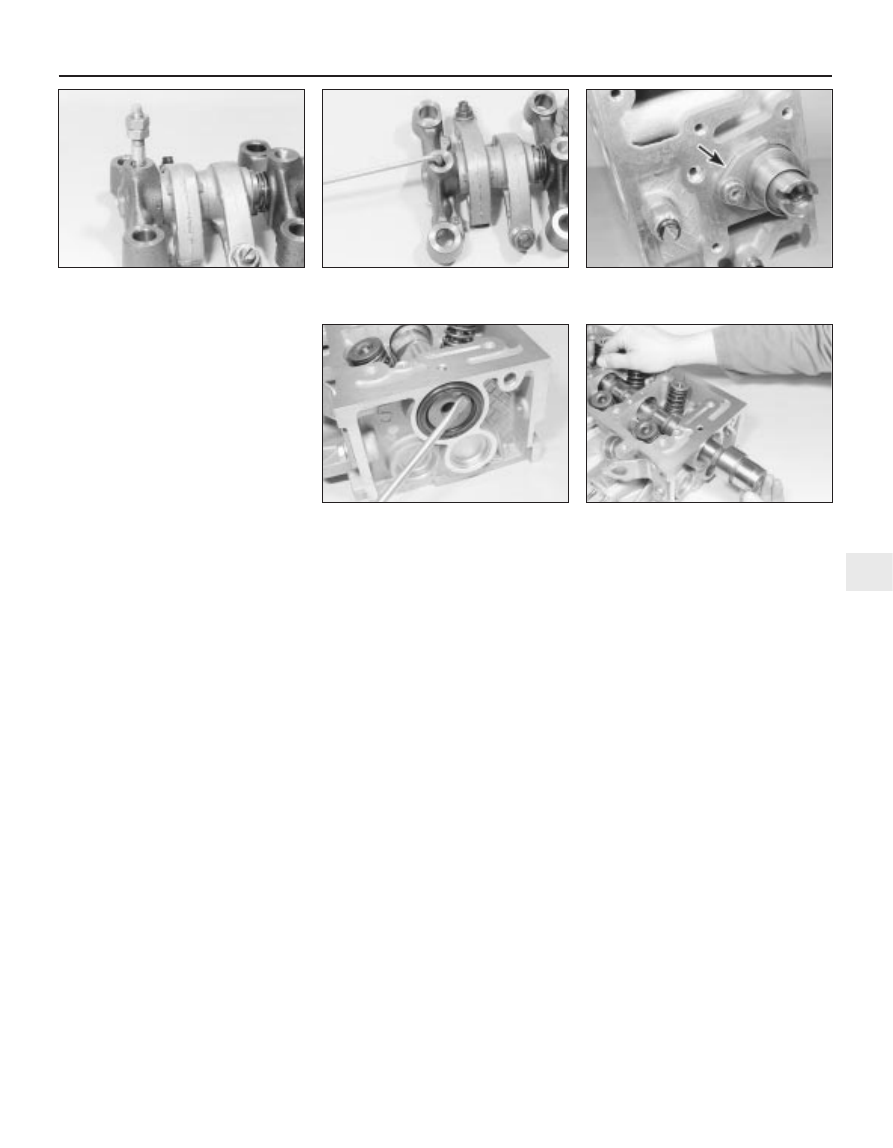Peugeot 405 Haynes (petrol). Manual - part 7

5 To separate the left-hand pedestal and
shaft, first unscrew the cylinder head cover
retaining stud from the top of the pedestal;
this can be achieved using a stud extractor, or
alternatively, by using two nuts locked
together. With the stud removed, unscrew the
grub screw from the top of the pedestal, and
carefully withdraw the rocker shaft (see
illustrations).
Camshaft
6 Remove the cylinder head as described in
Section 11.
7 With the head on a bench, remove the
locking pin, then remove the camshaft
sprocket as described in paragraphs 6 and 7
of Section 7.
8 Unbolt the housing from the left-hand end
of the cylinder head, then undo the retaining
bolt, and remove the camshaft thrust fork
from the cylinder head (see illustration).
9 Using a large flat-bladed screwdriver,
carefully prise the oil seal out of the right-
hand end of the cylinder head, then carefully
slide out the camshaft (see illustrations).
Discard the seal - a new one must be used on
refitting.
Inspection
Rocker arm assembly
10 Examine the rocker arm bearing surfaces
which contact the camshaft lobes for wear
ridges and scoring. Renew any rocker arms
on which these conditions are apparent. If a
rocker arm bearing surface is badly scored,
also examine the corresponding lobe on the
camshaft for wear, as it is likely that both will
be worn. Renew worn components as
necessary. The rocker arm assembly can be
dismantled as described in paragraphs 4
and 5.
11 Inspect the ends of the (valve clearance)
adjusting screws for signs of wear or damage,
and renew as required.
12 If the rocker arm assembly has been
dismantled, examine the rocker arm and shaft
bearing surfaces for wear ridges and scoring.
If there are obvious signs of wear, the relevant
rocker arm(s) and/or the shaft must be
renewed.
Camshaft
13 Examine the camshaft bearing surfaces
and cam lobes for signs of wear ridges and
scoring. Renew the camshaft if any of these
conditions are apparent. Examine the condition
of the bearing surfaces, both on the camshaft
journals and in the cylinder head. If the head
bearing surfaces are worn excessively, the
cylinder head will need to be renewed. If the
necessary measuring equipment is available,
camshaft bearing journal wear can be checked
by direct measurement, noting that No 1
journal is at the transmission end of the head.
14 Examine the thrust fork for signs of wear
or scoring, and renew as necessary.
Refitting
Rocker arm assembly
15 If the rocker arm assembly was
dismantled, refit the rocker shaft to the left-
hand pedestal, aligning its locating hole with
the pedestal threaded hole. Refit the grub
screw, and tighten it securely. With the grub
screw in position, refit the cylinder head cover
mounting stud to the pedestal, and tighten it
securely. Apply a smear of clean engine oil to
the shaft, then slide on all removed
components, ensuring each is correctly fitted
in its original position. Once all components
are in position on the shaft, compress the
right-hand pedestal and refit the circlip.
Ensure that the circlip is correctly located in
its groove on the shaft.
16 Refit the cylinder head and rocker arm
assembly as described in Section 11.
Camshaft
17 Ensure that the cylinder head and
camshaft bearing surfaces are clean, then
liberally oil the camshaft bearings and lobes.
Slide the camshaft back into position in the
cylinder head. On carburettor engines, take
care that the fuel pump operating lever is not
trapped by the camshaft as it is slid into
position. To prevent this, remove the fuel
pump before refitting the camshaft, then refit
it afterwards.
18 Locate the thrust fork with the left-hand
end of the camshaft. Refit the fork retaining
bolt, tightening it to the specified torque
setting.
19 Ensure that the housing and cylinder head
mating surfaces are clean and dry, then apply
a smear of sealant to the housing mating
surface. Refit the housing to the left-hand end
of the head, and securely tighten its retaining
bolts.
20 Lubricate the lips of the new seal with
clean engine oil, then drive it into position until
it seats on its locating shoulder. Use a
suitable tubular drift, such as a socket, which
bears only on the hard outer edge of the seal.
Take care not to damage the seal lips during
fitting. Note that the seal lips should face
inwards.
21 Refit the camshaft sprocket as described
in paragraphs 17 to 19 of Section 7.
22 Refit the cylinder head as described in
Section 11.
TU engine in-car repair procedures 2A•9
10.8 Undo the retaining bolt, and remove
the camshaft thrust fork (arrowed) . . .
10.9b . . . and slide out the camshaft
10.9a . . . prise out the oil seal . . .
10.5b . . . then remove the grub screw
10.5a To remove the left-hand pedestal,
lock two nuts together
and unscrew the stud . . .
2A